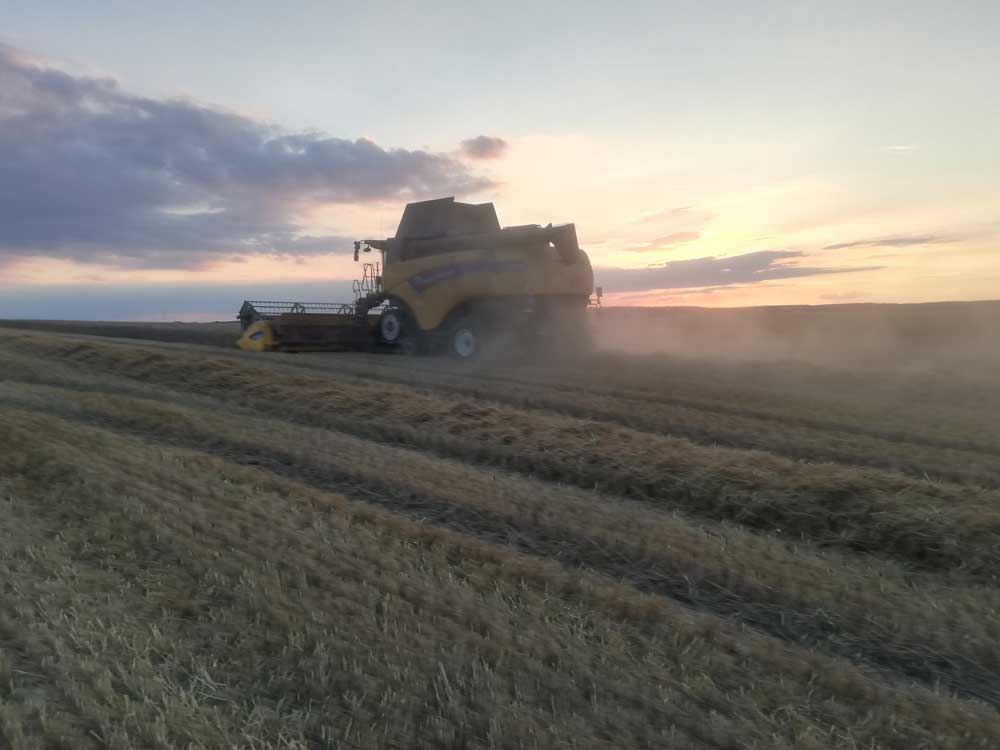Humus: Capture, conserve and promote
By Axel Don, Christopher Poeplau and Heinz Flessa, Thünen Institute for Agricultural Climate Protection, Braunschweig
Farmers know the positive effects of humus-rich, revitalised soil with a favourable soil structure. At the latest since the World Climate Conference in Paris in 2015, the importance of humus has also been intensively discussed in connection with climate protection. Two goals complement each other perfectly, don't they?
Humus consists of half carbon, is stable in parts for centuries and is fed exclusively by biomass whose carbon comes from carbon dioxide in the air. Humus build-up therefore leads to a reduction in the CO2 concentration in the atmosphere until a new humus equilibrium is established. On the other hand, humus losses accelerate climate change through increased CO2 emissions from soils.
A huge reservoir, but unevenly distributed
With the Germany-wide Soil Condition Survey Agriculture, consistent information on the humus reserves in agriculturally used soils and their influencing factors of more than 3,000 points is available for the first time. In Germany's agriculturally used soils, a total of 2.5 billion tonnes of carbon are stored in the upper metre as soil organic matter (humus and peat). This is more than twice as much as in the biomass of all German forests or about ten times the total annual emissions of CO2 carbon in Germany.
However, a closer look shows that soil carbon stocks in Germany are distributed very heterogeneously. This is primarily due to the diversity of sites: a shallow vineyard soil in Rhineland-Palatinate with only 9 t/ha of carbon in the upper metre and a northern German lowland moor soil with 1137 t/ha of carbon form the extremes here. On average, 528 t of carbon per hectare are stored in the upper metre of agriculturally used peat soils. These soils, which account for only about 6 % of the total agricultural area, concentrate 24 % of the total organic soil carbon in Germany's agriculturally used soils. They are mainly located in the north and north-west and in the foothills of the Alps. This peatland carbon is not stable, as rapid peat mineralisation takes place after drainage, making agricultural peatland soils a major source of greenhouse gases in Germany.
In the case of mineral soils, it is mainly grassland areas that have the highest carbon stocks with an average of 135 t/ha and store almost 40 t/ha more than those under arable land use. This also fits in with the fact that the humus stocks in fields with a grassland past or grassland rotation lie between those of permanent grassland and purely arable sites. The difference in humus reserves between arable and grassland soils is not only explained by the year-round vegetation cover and the very intensive rooting, but also by the fact that grassland is mainly found where arable farming becomes difficult: for example on heavy, wet soils.
The role of clay content
In fact, clay content plays a crucial role in explaining the carbon stocks in mineral soils. Heavy, clayey soils can store more humus than sandy soils due to their large mineral surface area and their ability to form stable microaggregates. A 10 % higher clay content leads on average to 0.4 % points more humus in the topsoil. That is a lot, because the average humus content in Germany is 3 % there.
But the correlation between clay content and humus content does not apply everywhere: So-called black humic sands are particularly common in northwestern Germany. They are relicts of past heath or moor vegetation or are due to plaggen farming and are characterised by exceptionally high humus reserves. So-called free, particulate organic matter (not bound to mineral surfaces and stabilised) forms up to 90 percent of the total humus stock in the black humic sands.
In addition to the clay content, the average groundwater depth has an influence on the humus reserves. In soils with groundwater influence in the upper metre, lack of oxygen availability leads to reduced humus decomposition by microorganisms and thus to more humus.
Humus contents decrease with increasing depth
Nevertheless, considerable stocks were also found in the subsoil (30 to 100 cm). For mineral soils, on average two thirds of the carbon stocks are stored in the topsoil (0 - 30 cm) and one third in the subsoil. However, a large number of soils were also found that had been profoundly altered by human intervention: Around 18 % of all mapped soil profiles showed severe disturbances in the profile structure, for example soils with backfill or deep tillage. Measures such as deep tillage strongly influence the depth distribution of humus.
Besides the type of land use (arable or permanent grassland), the location has the most important influence on the humus stock of mineral soils. Factors such as soil texture, groundwater influence and soil type first determine the humus level at which a soil can be. This is also described with the site-typical humus content classes, which were recently published in the Thünen Report 75. In addition to site factors, management has an influence on humus stocks. It is decisive for the temporal development of humus at a site.
Humus accumulation and decomposition are in equilibrium
In the long term, humus reserves result from a balance between the decomposition of humus by soil organisms and the build-up of humus fed by crop residues such as straw and roots as well as organic fertilisers. If this balance shifts, the humus reserves change. Humus maintenance and build-up are therefore linked to the input of organic material into the soil, crop residues, green manure, composts, farm manure from livestock farming and biogas production. These materials differ in their composition, degradability and effectiveness for the reproduction of humus. In order to be able to evaluate the different carbon inputs comparatively with regard to humus maintenance and humus formation, a distinction is therefore made between the total input of organic carbon and the humus-effective fraction. The latter increases with the stability of the carbon input.
In Germany, an average of 3.7 t/ha of organic carbon and 1.2 t/ha of humus-active carbon are added to arable soils per year. By far the largest part of this (80 %) is added to the soil in the form of crop residues such as roots and straw. Permanent grassland receives slightly more humus-active carbon (1.3 t/ha, 82 % from crop residues).
On average, organic fertilisation contributes only 12 % to the humus-active C input across all agriculturally used soils. The lion's share of humus-active organic fertilisation, 68 %, comes from cattle farming in the form of liquid manure and stable manure. Farm manure from pig farming, dry chicken manure and fermentation residues are mainly applied to arable land. At 1 %, compost accounts for only a small part of the total humus-active carbon input into agricultural soils.

What promotes humus build-up?
The available potential for humus reproduction and build-up in Germany is thus determined to a large extent by crop residues. Therefore, humus conservation and humus formation must primarily start with the crop residues. Sustainably high yields are important for humus conservation, because the amount of crop residues for humus reproduction increases with yields. However, looking at yields alone is clearly not enough. What is ultimately decisive is how much carbon is available in the crop rotations for humus formation. Humus-rich crop rotations can achieve higher humus contents even with lower yields, see organic farming. Ultimately, humus reproduction also requires the use of resources and inputs. Therefore, humus formation should not be evaluated in isolation from the expenditure involved. More plant material for humus formation can grow in the form of catch crops. This achieves the most permanent green cover possible. Their main aim is to keep nitrogen in the system and protect it from leaching. In Germany, winter catch crops are grown on only 12 % of arable land, while the share of summer crops is 32 %. There is therefore considerable potential. The biomass that grows in late summer and autumn contributes to the build-up of humus when incorporated. Drought in summer can prevent the successful establishment of catch crops. New cultivation methods are then necessary to establish catch crops as undersown crops.

The role of roots
Roots make a particularly efficient contribution to humus formation. One tonne of root litter produces two to three times as much humus as one tonne of above-ground biomass. Why is this so? Because the roots are already in the soil, where they can be transformed into humus and stabilised. In addition, living roots excrete exudates. These are organic compounds in the soil that ensure that roots get as many nutrients as possible. These exudates are rich food for microorganisms that contribute to the build-up of long-term stable humus. Crops that root more intensively and deeply contribute particularly to the build-up of humus. These are in particular perennial crops such as lucerne and clover grass.
Organic fertilisers
Liquid manure, dung and fermentation residues are valuable sources of nutrients and at the same time influence humus reproduction. The use of these fertilisers is primarily about efficient and low-loss nutrient recycling and only secondarily about a contribution to humus preservation. Their use is limited by their nutrient content in order to avoid the negative effects of overfertilisation. They unfold their climate protection potential primarily by saving mineral fertiliser as efficiently as possible.
The various organic fertilisers differ in terms of their humus effectiveness. The more a substrate has already been microbially converted, the more stable it is and the higher its specific humus effectiveness. However, this comparison does not take into account how much organic carbon was invested in the formation of the fertilisers (e.g. as animal feed). If one takes into account the initial carbon investments and compares, for example, the humus reproduction performance of fresh biomass (maize, alfalfa) with that of manure and digestate from the same substrate, all three variants show very similar humus reproduction performances.
Reduced tillage
Reduced tillage or a complete abandonment of the plough hardly changes the humus reserves, but leads to a redistribution in the soil profile: humus accumulates at the soil surface and is lost in the deeper areas of the topsoil (15 - 30 cm). This has been demonstrated in many long-term trials with no-till or reduced tillage and a conventionally ploughed control variant. In dry areas, however, not tilling the soil can have a positive effect on soil water availability and yields. Since the amount of crop residues also increases with rising yield, the humus stock can be increased in this case with less tillage, depending on the yield. Humus build-up is therefore possible when more plant material is brought into the soil and converted into humus there.
Conclusion
The challenge of humus management is to think together its effects on soil fertility, yield security and nutrient balances, as well as on soil and climate protection, and to implement them through site- and farm-optimised measures. How successful these measures are on a national scale to maintain and build up humus will be ascertainable with a second soil condition survey, which is planned for 2023 to 2028.




